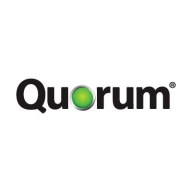

Teradata and Quorum OnQ are competitors in the data management and disaster recovery categories. Teradata has the upper hand in data processing with its robust analytics capabilities, while Quorum OnQ leads in disaster recovery through its efficient recovery features.
Features: Teradata is recognized for its massive parallel processing, efficient cross-platform query execution, and robust workload management. It includes advanced analytics features such as geospatial and temporal analytics and a "shared nothing" architecture for scalability. Quorum OnQ is prominent for its disaster recovery capabilities including one-click recovery, efficient data protection, and automated testing that validate backups for reliability and performance.
Room for Improvement: Teradata faces challenges in cost management, cloud integration, and handling unstructured data. It also lags in adopting innovative features. Quorum OnQ can improve platform compatibility and streamline user interfaces, as well as make deployment processes simpler and more cost-effective.
Ease of Deployment and Customer Service: Teradata provides versatile deployment options across on-premises, private cloud, and hybrid environments, with generally positive technical support though response times may vary. Quorum OnQ, usually deployed on-premises, offers an easy-to-use interface but lacks the deployment breadth of Teradata, and its customer service is highly rated for its strong user support.
Pricing and ROI: Teradata is an expensive solution known for high performance and comprehensive features, offering significant ROI for large enterprises but posing a barrier for smaller businesses due to high costs. Quorum OnQ presents a more cost-effective option for smaller enterprises focused on disaster recovery but remains priced on the higher side within its segment. Both highlight ROI through operational efficiency and reduced downtime.
We have realized a return on investment, with a reduction of staff from 27 to eight, and our current return on investment is approximately 14%.
The customer support for Teradata has been great.
Customer support is very good, rated eight out of ten under our essential agreement.
The technical support from Teradata is quite advanced.
This expansion can occur without incurring downtime or taking systems offline.
Teradata's scalability is great; it's been awesome.
Scalability is complex as you need to purchase a license and coordinate with Teradata for additional disk space and CPU.
I find the stability to be almost a ten out of ten.
The workload management and software maturity provide a reliable system.
The URL for our environments is the same, making it confusing for management when handling different departments with different needs.
Unlike SQL and Oracle, which have in-built replication capabilities, we don't have similar functionality with Teradata.
If Teradata could provide a list of certified experts, that would be fantastic.
It's a little expensive.
Teradata is much more expensive than SQL, which is well-performed and cheaper.
Initially, it may seem expensive compared to similar cloud databases, however, it offers significant value in performance, stability, and overall output once in use.
We spent roughly $295,000 on setup costs.
Quorum OnQ provides an elevated ability to filter on everything from people's location to age to their voting history.
Teradata's security helps our organization meet compliance requirements such as GDPR and IFRS, and it is particularly essential for revenue contracting or revenue recognition.
The data mover is valuable over the last two years as it allows us to achieve data replication to our disaster recovery systems.
| Product | Market Share (%) |
|---|---|
| Teradata | 0.3% |
| Quorum OnQ | 0.5% |
| Other | 99.2% |


| Company Size | Count |
|---|---|
| Small Business | 19 |
| Large Enterprise | 4 |
| Company Size | Count |
|---|---|
| Small Business | 26 |
| Midsize Enterprise | 12 |
| Large Enterprise | 49 |
Quorum onQ is the global leader in 1-click instant recovery, providing full immediate recovery of your critical systems after any storage, system or site failure. It does this by automatically maintaining up-to-date, ready-to-run virtual machine clones of your physical and virtual servers stored on a dedicated appliance – clones that will transparently take over for failed servers within minutes.
Teradata is a powerful tool for handling substantial data volumes with its parallel processing architecture, supporting both cloud and on-premise environments efficiently. It offers impressive capabilities for fast query processing, data integration, and real-time reporting, making it suitable for diverse industrial applications.
Known for its robust parallel processing capabilities, Teradata effectively manages large datasets and provides adaptable deployment across cloud and on-premise setups. It enhances performance and scalability with features like advanced query tuning, workload management, and strong security. Users appreciate its ease of use and automation features which support real-time data reporting. The optimizer and intelligent partitioning help improve query speed and efficiency, while multi-temperature data management optimizes data handling.
What are the key features of Teradata?In the finance, retail, and government sectors, Teradata is employed for data warehousing, business intelligence, and analytical processing. It handles vast datasets for activities like customer behavior modeling and enterprise data integration. Supporting efficient reporting and analytics, Teradata enhances data storage and processing, whether deployed on-premise or on cloud platforms.
We monitor all Backup and Recovery reviews to prevent fraudulent reviews and keep review quality high. We do not post reviews by company employees or direct competitors. We validate each review for authenticity via cross-reference with LinkedIn, and personal follow-up with the reviewer when necessary.